Swiftech Polaris 120 and EVGA Superclock CPU Coolers Review

Today we are going to talk about two coolers with identical heatsinks using enhanced direct touch technology in their base. Is it a breakthrough or just another step forward?
The direct-touch technology has been employed in CPU coolers for as long as four years already. Over this time it has progressed from compact coolers with only three heat pipes placed 3 millimeters apart from each other to heavy dual-tower super-coolers with as many as five pipes. However, despite the lower manufacturing cost compared to coolers with the classic design of the base, direct-touch coolers do not dominate the market. Oddly enough, the direct touch technology itself is the Achilles’ heel of such products.
As you know from our reviews, there are 1 to 3mm gaps between the heat pipes in the base of such coolers, including the Coolink Corator DS. These gaps prevent the cooler from taking heat off the CPU in a steady and uniform manner. This factor has become crucial with the rising popularity of multicore CPUs in home computers, so users of such systems often prefer classic CPU coolers.
The direct-touch technology keeps on developing, though. Today, I will review two identical coolers that feature an improved version of it. They do not have gaps between the heat pipes and they are called Swiftech Polaris 120 and EVGA Superclock.
Packaging and Accessories
The product boxes are identical in size and shape.
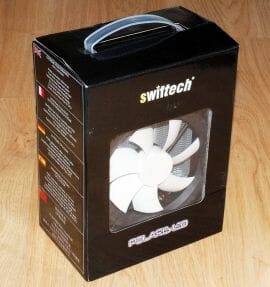
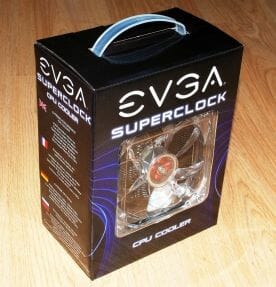
They are decorated differently and present product information in different ways.
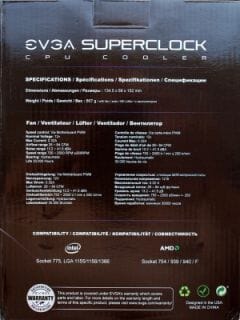
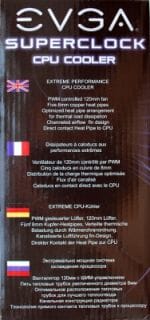
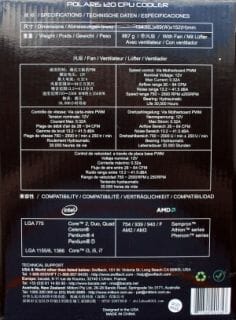
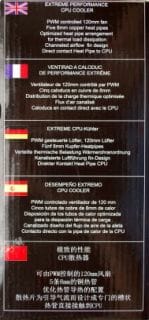
The two products have the same accessories: an installation manual, a steel back-plate, sets of fasteners and spacers for all modern computing platforms, and two wire brackets to fasten a fan.
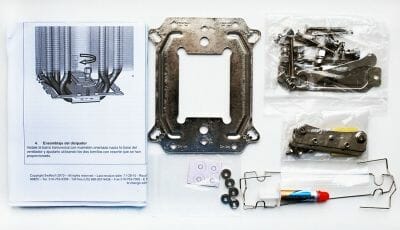
IceHammer’s thermal grease is included into the box, indicating the actual maker of the coolers’ heatsinks.
The coolers are both manufactured in China (most likely at the same factory). The warranty period is 1 year whereas the recommended price differs: $59.95 for the Swiftech Polaris 120 and $54.99 for the EVGA Superclock.
Design and Functionality
So, here they are – the early representatives of the new step in the evolution of the direct-touch technology.
The EVGA Superclock differing from the Swiftech Polaris 120 in two things only, namely the fan and the black color of the heatsink, I will be talking about the Polaris 120, referring to the Superclock where necessary.
So, it is a tower-design heatsink that has five copper heat pipes, 8 millimeters in diameter, in its base. There are aluminum fins on those pipes.
The heatsink measures 152x135x91 millimeters.
The two coolers differ in weight. The Superclock is 867 grams and the Polaris 120 is 849 grams. The difference must be due to the weight of the fans and the black paint of the EVGA cooler.
The heatsinks are assembled properly. The fins do not wobble on the pipes. Even the top decorative plate sits firm. There are a total of 46 fins. They are 0.5millimeters thick and 2 millimeters apart from each other.
For all its simplicity, the heatsink has two original features. The first one is that the heat pipes are placed in such a way that the three central ones, which do the bulk of work, are in the middle of the fan’s air flow. Here is a picture to illustrate this.
As you can see, the heat pipes do not overlap and do not block the air flow for each other. This is good in terms of achieving maximum cooling performance.
Besides, the engineers focused the air flow in the hottest part of the heatsink by making an egg-shaped hole in its center.As a result, the stream of air from the fan splits up in two and goes along that part of the heatsink fins where the heat pipes are located.
The center hole with blank walls helps focus the air flow in the hottest part of the heatsink and thus make the most efficient use of the air supplied by the fan. This is the heatsink’s second special feature. The edges of the fins are serrated to reduce their resistance to the incoming air whereas the surface is convex. The total heatsink area is no larger than 6200 sq. cm, which is not much by today’s standards and may be insufficient for cooling a high-TDP CPU.
Now let’s compare the direct-touch technology implemented in the Alpenföhn Nordwand or IceHammer IH-4500 with the improved version of the same technology as it is implemented in the EVGA Superclock and Swiftech Polaris 120.
It’s clear that the new direct-touch should ensure a more uniform transfer of heat from the surface of the CPU despite the tiny gaps between the pipes.
The sole of each cooler is perfectly flat. Here are the imprints left on my LGA1366 CPU by the Swiftech Polaris 120.
To capture the last pair of photos I used a thermal interface material which was more viscous and fluid than Gelid GC-Extreme used for the first two pairs of photos. You can also note that the last pair of photos was shot with the cooler oriented in a different way. The difference in performance is small, about 1.5 to 2°C under peak load, but in favor of the first orientation variant.
Now I want to tell you about the coolers’ fans. Both are designed in the same way. They have 7 blades and measure 120x120x25 millimeters. The Polaris 120’s fan has a black frame and a white impeller whereas the Superclock’s fan has a translucent frame and impeller.
The fans have identical specs. Both are PWM-controlled within a speed range of 750 to 2500 RPM, producing an air flow of 26.56 to 83.32 CFM at 13.2 to 41.5 dBA of noise. The pressure is 1.74 to 4.85 millimeters of water. The fluid dynamic bearing is supposed to last for no less than 30,000 hours or 3.4 years of nonstop operation. The peak power consumption is 4 watts.
This is what’s written in their specs but the fans turned out to have different electronics. For example, the Swiftech Polaris 120 had a startup voltage of 3.5 volts and consumed 4 watts per hour, just as specified, at its maximum speed. The Superclock’s fan could only start at a voltage of 6.5 volts and consumed over 5.2 watts. Moreover, this fan had a speed of 1760 RPM at 7 volts but slowed down suddenly to 1060 RPM at 6.7 volts. At 6.5 volts it had a speed of only 510 RPM! This fan would change its speed in leaps in PWM mode, switching from quiet to noisy in just a couple of seconds, which wasn’t comfortable.
The fan of the EVGA Superclock has four red LEDs for highlighting and is secured on the heatsink with two wire clips.The two coolers do not allow for the installation of a second fan.
Installation Tips
It goes without saying that the EVGA Superclock and Swiftech Polaris 120 are both compatible with all modern computing platforms. This has become not just good manners for the manufacturers of CPU coolers but a kind of a rule that everyone follows, including IceHammer EVGA and Swiftech. The installation procedure is detailed in the manual and is no different from the way that many other coolers are installed. Here is a photo of the cooler’s fastening mechanism.
As I noted above, the most effective orientation of a direct-touch cooler on an LGA1336 CPU is with the heat pipes lying across the CPU’s heat-spreader, so that the area of contact is larger. This applies to the EVGA Superclock and Swiftech Polaris 120 as well (the photos on the right show the better orientation).
The difference between the two orientation variants in the peak temperature of the hottest CPU core is 1.5 to 2°C. I should note that the picture can be different with LGA1155/1156 and LGA775 CPUs as well as with AMD processors. I didn’t check this out during my tests.
Testbed and Testing Methodology
We performed all cooler tests inside a closed system case. Here is our testbed configuration:
- Mainboard: Gigabyte GA-X58-UD9 (Intel X58 Express, LGA 1366, BIOS F5 from 5/4/2011);
- Processor: Intel Core i7-980X Extreme Edition, 3.33 GHz, 1.225 V, 6 x 256 KB L2, 12 MB L3 (Gulftown, B1);
- Thermal interface: Gelid GX-Extreme;
- Graphics card: ATI Radeon HD 5770 1 GB GDDR5 128 bit, 850/4800 MHz;
- Memory: DDR3 3 x 2 GB OCZ Platinum Low-Voltage Triple Channel (Spec: 1600MHz / 7-7-7-24 / 1.65 V);
- System drive: RAID-0 of 2 x Kingston V-series SNV425S2128GB SSD (SATA-II, 128 GB, MLC, Toshiba TC58NCF618G3T controller);
- Drive for programs and games: Western Digital VelociRaptor (300GB, SATA-II, 10000 RPM, 16MB cache, NCQ) inside Scythe Quiet Drive 3.5” HDD silencer and cooler;
- Backup drive: Samsung Ecogreen F4 HD204UI (SATA-II, 2 TB, 5400 RPM, 32 MB, NCQ);
- System case: Antec Twelve Hundred (front panel: three Noiseblocker NB-Multiframe S-Series MF12-S2 fans at 1020 RPM; back panel: two Noiseblocker NB-BlackSilent PRO PL-1 fans at 1020 RPM; top panel: standard 200 mm fan at 400 RPM);
- Control and monitoring panel: Zalman ZM-MFC2;
- Power supply: Xigmatek “No Rules Power” NRP-HC1501 1500 W (with a default 140 mm fan).
We overclocked our six-core processor (with its default non-lapped heat-spreader) with the multiplier set at 25x and “Load-Line Calibration” (Level 2) enabled to 4.325 GHz. The nominal processor Vcore was increased to 1.4 V in the mainboard BIOS.
Turbo Boost and Hyper-Threading technologies were disabled during our test session. The memory voltage was at 1.64 V and its frequency was 1.4 GHz with 7-7-7-16_1T timings (Extreme profile). All other parameters available in the mainboard BIOS and related to CPU or memory overclocking remained unchanged.
All tests were performed under Windows 7 Ultimate x64 operating system. We used the following software during our test session:
- CPU Stress Test (CST) version 0.18b – to load the processor (matrix # 15, 10-12 minutes);
- Real Temp GT 3.64 – to monitor the processor core temperature;
- CPU-Tweaker 1.5 – to visually monitor temperatures and frequencies using graphics;
- Gigabyte Easy Tune 6 B11.2303.1 – to monitor voltages.
The CPU was loaded with two consecutive CST test runs with the settings as indicated above. The stabilization period for the CPU temperature between the two test cycles was about 8-10 minutes. We took the maximum temperature of the hottest CPU core for the results charts. Moreover, we will also provide a table with the temperature readings for all cores including their average values. The ambient temperature was checked next to the system case with an electronic thermometer with 0.1 °C precision that allows hourly monitoring of the temperature changes over the past 6 hours. The room temperature during our test session varied between 21.2-21.5 °C.
The noise level of each cooler was measured between 1:00 and 3:00 AM in a closed room about 20 m2 big using CENTER-321 electronic noise meter. The noise level for each cooler was tested outside the system case when the only noise sources in the lab were the cooler and its fan. The noise meter was installed on a tripod and was always at a 150 mm distance from the cooler fan rotor. The tested cooling systems were placed at the edge of the desk on a sheet of polyurethane foam. The lowest noise reading our noise meter device can register is 29.8 dBA and the subjectively comfortable noise level in these testing conditions was around 36 dBA (do not mix it up with low noise level). The fan(s) rotation speed was adjusted in the entire supported range using our in-house controller by changing the voltage with 0.5 V increment.
Besides checking out the efficiency of the two new twin-brothers, we will also compare them against the leader among coolers with heatpipe direct touch technology – Alpenföhn Nordwand ($64.90) and against the best cooler in its class with a traditional base – Zalman CNPS10X Performa ($40).
Both competitors were tested only in one configuration with one default fan in the entire rotation speed range using 200 RPM increments.
Cooling Efficiency Tests
For a starter, here is the Swiftech Polaris 120 working at 800 RPM on a non-overclocked six-core CPU.
As you can see, it is very easy for the Swiftech Polaris 120 (and the EVGA Superclock, too) to cool a six-core CPU at the latter’s default clock rate and voltage even when the cooler’s fan speed is set at the minimum. The temperature of the hottest CPU core is no higher than 60°C under load. It is clear that the new coolers are meant for more serious tasks, so let’s check out how they cope with an overclocked CPU. You can see the results in this table as well as in the diagram below.
The results are grouped according to the noise level: low (800-1000 RPM), medium (1200-1400 RPM) and high (from 1400 RPM up). Let’s see what we have in each group.
Unfortunately, in the low-noise group the Swiftech Polaris 120 is not very effective and is inferior to the direct-touch Alpenföhn Nordwand by more than 5°C at 800 RPM and by 7°C at 1000 RPM under peak CPU load. The Zalman CNPS10X Performa easily beats every other cooler in this test whereas the EVGA Superclock didn’t even make it into this group due to the peculiar behavior of its fan I described above.
The two new coolers aren’t impressive in the medium-noise group, either. They are inferior to the Alpenföhn Nordwand. At a speed of 1200 RPM the Polaris 120 is 7°C and the Superclock is 6°C worse than the Nordwand. The gap is 6°C at 1400 RPM. You can also note that the new direct-touch coolers depend heavily on the speed of the fan. Within a range of 800 to 1800 RPM each subsequent 200RPM increase in speed lowers the peak temperature of the hottest CPU core by 4, 5, 4, 3 and 3°C for a total of 18°C! Considering that the fins in the new coolers’ heatsinks are placed at a distance of 2 millimeters from each other, I suppose that the heatsinks are just too small.
As for the high-noise results, the new coolers are both better than the Alpenföhn Nordwand with its low-speed default fan and also close to the leader Zalman CNPS10X Performa. The extra 500RPM of speed increase their noise substantially, though, as I will show you shortly. Take note that the EVGA Superclock is somewhat more efficient than the Swiftech Polaris 120 in the high-speed group, even though this can hardly make any practical difference.
Winding up the performance tests, I will show you the results of my overclocking the six-core CPU with each cooler.
Working at the maximum fan speed, the Swiftech Polaris 120 and the EVGA Superclock made the CPU stable at 4450 MHz and 1.45 volts. The CPU temperature was as high as 85°. The Alpenföhn Nordwand is somewhat worse, stopping at 4425 MHz, 1.44375 volts and 88°C. The Zalman CNPS10X Performa has the same result as the Polaris 120 and Superclock. That’s good, yet not as good as I had expected from the new coolers.
Noise Level
The amount of noise produced by the coolers was measured throughout the speed range of their fans according to the method explained above. You can see the results in the following diagram with table.
As you can see, the coolers included into this test session do not differ much in terms of noisiness. The Alpenföhn Nordwand is the quietest of the four, its fan working smoothly throughout the entire speed range. The EVGA Superclock is quieter than the Swiftech Polaris 120 but changes its fan speed rather abruptly whereas the Polaris 120’s fan behaves in a steadier manner.
Conclusion
It’s hard to tell what exactly prevented the Swiftech Polaris 120 and the EVGA Superclock from doing better in my tests because their heatsinks represent a very thought-through design with cleverly positioned heat pipes, optimized air flow, and the best-ever implementation of the direct-touch technology. The number of heat pipes (8 millimeters in diameter, by the way) seems sufficient, too. So, I can only see one downside about the new coolers. Their heatsinks have a small overall effective area, which makes the coolers dependent on the speed of the fan. With the fan working at full speed, they delivered high performance, beating the best product from the previous generation of direct-touch coolers.
The type of the heat pipes may be another issue. Zalman and Thermalright have been working on that and Zalman’s recent products deliver unexpectedly high performance (for their design) whereas Thermalright is in fact the leading maker of air-based CPU coolers. I guess the original manufacturer of heatsinks for Swiftech, EVGA and other brands should do something about the heat pipes, too. Until that, we’ll be getting good, but not exceptional, coolers like the two new ones discussed today.
Having a somewhat lower recommended price, EVGA Superclock seems preferable to Polaris 120, as it is also quieter and prettier, but its fan is capricious in PWM mode and not stable at low speeds. The choice is yours as always, though.